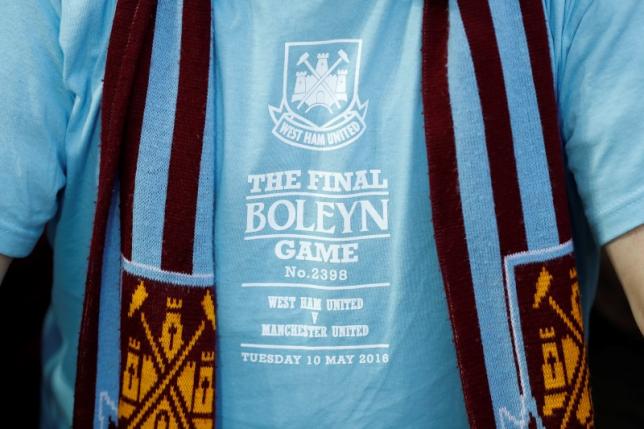West Ham leave home as English landscape changes
LONDON: The Boleyn Ground did not go quietly, that is just not the West Ham United way, but after hosting one last emotional hurrah it stood silent on Wednesday, condemned to the history books.
Broken glass still carpeted the streets around the club's home of 112 years the morning after the incident-packed night before, while claret and blue scarves adorned the statue of their England great Bobby Moore on the corner of Green Street.
That statue will soon be whisked four kilometres up the road to the 60,000-seat Olympic Stadium where the Hammers will begin a new era next season with a golden future beckoning.
While West Ham's owners talk boldly of taking the under-achieving London outfit to a new level, many will mourn another of England's iconic clubs being ripped out of its community.
"I think it's terrible for the area. (The football club) is the only thing that's left here," Nikki Harvey, who has been serving burgers outside the Boleyn for 25 years, said.
"Up there (at the Olympic Stadium in Stratford) it will have none of the street atmosphere. This is like a carnival on match day. It's tragic that's what it is!"
When the Premier League kicks off next season at least eight clubs, 10 if Sunderland stay up and Derby County are promoted, will do so in stadiums built since 1995. Three others, Chelsea, Tottenham Hotspur and Everton, have new ones in the pipeline.
West Ham's Boleyn, which survived a direct hit by a doodlebug bomb in World War II, will be demolished for housing, although a new Moore statue is planned as a link to the past.
It is a familiar tale.
QUIRKY STADIUM
Champions Leicester City vacated Filbert Street in 2002. It is now university accommodation.
Manchester City moved from Maine Road to what is now the Etihad Stadium in 2003 and where the Kippax terrace once stood another housing development has sprung up.
The Dell, Southampton's quirky stadium where they played since 1898, met its end in 2001, while Arsenal left the marble-halled Victorian splendour of Highbury in 2006 for the sweeping curves of the Emirates Stadium a short distance away.
Outside the Premier League it is a familiar story with Derby's Baseball Ground, Cardiff City's Ninian Park, Bolton Wanderers' Burnden Park and Coventry City's Highfield Road (England's first all-seater stadium) all long gone.
Not everybody wants to live in the past and for some fans a new ground brings benefits on and off the pitch.
"Move with the times or get left behind," said Southampton fan Tim Cook. "I grew up going to the Dell in the 1980s and I have great memories of watching (Kevin) Keegan, (Peter) Shilton, (Mick) Channon there... great, great times.
"I now take my boys to St Mary's. It is a fantastic 21st century ground. I loved the Dell, but I wouldn't want to go back. I'm lucky -- I've known both.
"I'll always have a soft spot for the Dell, but it isn't like we moved city... we're still in Southampton, and we have a stadium to be proud of."
POIGNANT MOVE
West Ham's move from the earthy Victorian neighbourhood that has been home since 1904 to a concrete bowl neighbouring the posh shops and bars of Westfield shopping centre, is poignant.
Butted up next to the Lady of Compassion Church, overlooked by a 1950s tower block and surrounded by a patchwork of Asian shops, greasy spoon cafes and the rough and ready Queens Market, the Boleyn co-exists at the heart of a community.
Even St Edwards Roman Catholic School in the shadow of the Bobby Moore Stand is painted claret and blue.
No wonder emotions were mixed on Tuesday night as West Ham signed off with a 3-2 win over Manchester United in the Boleyn's 2,398th game -- a floodlit thriller amidst a cacophony of noise after a 45-minute delay caused by an attack on the visiting team's bus.
Like many of the independent traders who do a thriving match-day business around Upton Park, local trader Harvey is not sure what the future holds or whether she will even be welcome on the manicured surrounds of the new stadium.
She plans to relocate her take-away van to the fringes of the Olympic Park next season, while others selling programmes, scarves and memorabilia are still in talks with the London Legacy Development Corporation (LLDC) over proposed pitches.
SAD INDICTMENT
West Ham's move to a stadium that cost 700 million pounds ($1.01 billion) of mainly taxpayers money, for a seasonal rent of 2.5 million pounds plus add ons, sounds like great business.
It should ensure annual revenues approaching 200 million pounds and, with 52,000 season tickets already sold, it seems fans are buying into co-chairman Karren Brady's mantra that the club is poised to become one of the 10 most powerful in Europe.
But what about the heart and soul of the club?
"It's a sad indictment on the state of football," Bruce Pangay, who sells scarves and hats outside the ground, said.
"It's going to be homogenised and generic over there (at the Olympic Stadium). I think this area will really suffer once the club goes.
Others are prepared to trade history for silverware, which West Ham have not enjoyed since the 1980 FA Cup.
"I'm not sure the atmosphere will be the same," Richard Laroche, a fan of 45 years who already has a season ticket for next season, said. "I'll miss this. But that might be the price for having a better team."






